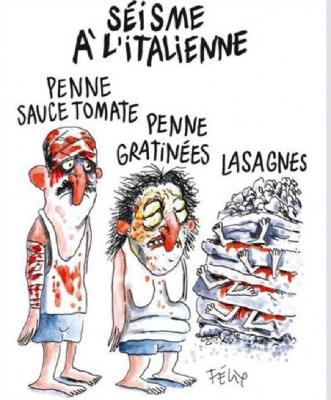Charlie Hebdo controversy over Italian quake cartoon

ROME -- The French satirical weekly Charlie Hebdo’s latest publication is still sparking controversy after the world noticed their cartoons about the recent earthquake in central Italy and criticisms went viral.
The satirical images in the magazine’s latest issue were entitled “Earthquake Italian-style: penne pasta with tomato sauce, gratinéed penne and lasagne.” The cartoon below is made up of three images, each representing the different styles of pasta mentioned in the title, with two characters covered in bandages and blood and the lasagne image showing various people buried in layers of ruins.
Next to another drawing of the earthquake, on the final page of the publication, a line of text reads “About 300 dead in an earthquake in Italy. It remains unknown whether the quake shouted ‘Allah akbar’ before trembling.”
The pictures sparked more criticism than laughter, first on social networks, then amongst Italian political circles of all political alliances. It caused the French embassy in Rome to issue a statement of solidarity saying that “France has expressed its sincere condolences to the Italian authorities and people and has offered its help. We stand next to Italy in this difficult test. In relation to the caricatures in the press, the journalists’ opinions are free to be expressed but this image absolutely does not represent France’s position.”
However, the non-conformist magazine then issued a response to criticisms on Facebook Friday afternoon that reads, “Italians, do not get angry at us, it is the mafia that builds your houses.” It appears together with drawing of a person covered in blood under ruins of a collapsed house.
Amongst notable criticisms from Italian politicians, came accusatory statements of “disgust”, “idiocy” and “very bad taste,” according to ‘Il Fatto Quotidiano’. Michele Anzaldi, member of the Democratic Party, said that images are “embarrassing and shameful,” and continued that “Those 294 dead, all those children left under the ruins, cannot become an occasion for an irony that is completely out of place, just to try to sell a few more publications. Moreover, rescuers are still digging for victims at this very moment.”
The cartoons were not even liked by the maestro of satire Sergio Staino who, in an interview with Ansa, said, “ I think that it is a cartoon in line with Charlie Hebdo’s history. It is not the first time that, just to be provocative, they decide to go against everything and everyone in moments of great pain.” For Staino the magazine “wanted to link the old ‘macaroni’ stereotypes of the country to the tragedy, but the result is of a very poor level. Not even a drunkard or the village idiot would do something like this, what is the point? I distance myself from a creative intervention of this type that does not have any meaning, at least according to the way I understand satire.”
nkd


